- Digital Edition
- U.S. & World News
- Already/Not Yet
- Amid the Fray
- Ask Father Mike
- Bridging Faith
- Catholic — or Nothing
- Catholic Watchmen
- Echoes of Catholic Minnesota
- Everyday Mercies
- Faith at Home
- Faith Fundamentals
- Faith in the Public Arena
- Food from Scripture
- Inside the Capitol
- The Local Church
- Making Sense Out of Bioethics
- Simple Holiness
- Twenty Something
- Word on Fire
- Your Heart His Home
- From Readers
- Focus on Faith
- Sunday Scriptures
- Daily Scriptures
- Why I am Catholic
- Practicing Catholic
- Movie Reviews
- And the beautiful
- Video Game Reviews
- Local Events
- Classifieds
- Publication Dates


Before you go
Sign up for our free newsletter, visit the imprisoned.
To visit the imprisoned is a corporal work of mercy. Jesus mentioned it specifically when he said, “For I was . . . in prison and you visited me” (Mt 25:35, 36).
Jesus has mercy for “the least,” those despised by others. Convicts rank high among “the least.” For the general public, when a criminal gets prison time, the criminal is getting what is deserved; the criminal needs to pay for what has been done. Jesus understands the brokenness of those who have done hateful things. From the cross Jesus said, “Father, forgive them, they know not what they do” (Lk 23:34).
Jesus wants us to have compassion for those in jail or prison. Instead of having an attitude of anger, retribution, punishment or vengefulness, Jesus wants us to be merciful. We need to honestly acknowledge our own inclination to evildoing and admit, “There, except by the grace of God, go I.” Many of us are all lucky to be a “step ahead of the law,” because all of us have gotten away with something for which we deserve to be punished.
Inmates are real human beings. Prison time is hard time. It is lonely time. It is dangerous time. Prisoners need help, support, encouragement and prayers. And as Jesus explained, a visit is a great way to help a prisoner.
Visiting prisoners is not so easy these days. Security measures have been strengthened and access is restricted. A prisoner can place several names on an approved list of visitors, and volunteers can gain access to inmates only after training and background checks. So how can the average person perform the corporal work of mercy to visit the imprisoned?
If you know someone who is in prison, and if you are on the approved list of visitors, make every effort to go and visit the person. Your presence will be a great blessing.
Consider prison ministry. Ministries include prayer services, Bible studies, retreats, religious book clubs and pastoral visits. Step forward. Offer your services. Go through the orientation for jail volunteers. Submit to the background check. Embark on the corporal work of mercy of visiting the imprisoned.
Because security measures keep most people out of jails and prisons, there are spiritual things that the average person can do for those who are incarcerated. First and foremost, we can pray for those in prison. Pray that inmates, in their isolation, will know God’s constant presence and love. Pray for their safety in the face of danger. Pray for their conversion as they deal with their troubled past. And, as they deal with separation from family and friends, pray that they will receive forgiveness, a second chance and continuing support.
We can turn to St. Dismas, the criminal who was crucified next to Jesus (Lk 23:40-43), the “good thief” and the patron saint of inmates, to intercede on behalf of those who are in prison. We can also turn to St. Barbara, the other patron saint of inmates, and St. John Cafasso, the patron saint of prisons, who served prisoners, heard their confessions, granted them absolution and accompanied them on their way to the gallows. We can also work to abolish capital punishment, support halfway houses, correspond with prisoners, assist the families of those who have someone in prison, and support parish and diocesan ministries to the incarcerated.
Father Van Sloun is pastor of St. Bartholomew in Wayzata.
Related Articles
Angels among us: how helping leads to healing, admonish the sinner, delano deacon devotes decades to digging graves as he prays for those laid to rest, family meals and the rosary.
ARCHDIOCESAN SYNOD 2022 ARCHDIOCESE OF ST. PAUL & MPLS.
Contact us: [email protected]
777 Forest St., St. Paul, MN 55106 © 2022 TheCatholicSpirit.com. All rights reserved.

- Bishop Kettler's Column
- Bishop Neary's Column

Thanks to area Knights, small treat makes big difference

Photos: Eucharistic Revival formation event with Dr. Timothy O’Malley

Upcoming local events

SECOND UPDATE: In Nigeria, women religious are rescuing, rehabilitating victims of human trafficking

Spring semester: ‘School of Prayer’ now in session for Holy Year finals

Lay Catholics have key role in church’s mission in today’s world, says top Knight
- Faith in the Public Arena
- From the Editor

‘It is the Lord!’

Ask Father Tom: Living the Dream

See you in the story
- Ask Father Tom
- Food for the Journey | Fr. Ron Rolheiser
- Igniting our Faith | Bishop Robert Barron
- In Light of Faith
- In the know with Father Joe
- Marriage Matters
- Parenting Journey
- Question Corner | Fr. Kenneth Doyle
- Sunday Scripture Readings
- Thanksgiving
- Theology 101

Praying through the headlines in the year of prayer

Why Catholics make the sign of the cross

Explainer: What are indulgences?
- Book Reviews
- Movie Reviews
- Video Game Reviews

“Irena’s Vow,” Heroism in the Face of Evil

The reconstruction of Notre Dame is a symbol of hope

Artist Daniel Mitsui: A portfolio that balances tradition with innovation
- Catholic Social Teaching
- Eucharistic Revival
- Bishop Kettler's Pastoral Letter
- El Visitante
- Laudato Si Study Session
- Melrose Church Fire
- Pastoral Planning
- Safe Environment Articles
- The 7 Sacraments
- YAYA Awards

6 things you need to know about the second round of Synod listening

Father Ron Rolheiser: Reindeer Games

Photos of the week Feb. 23, 2024

Santo del Mes: Salvador Lara Puente Y Los Mártires De Laguerra Cristera

El Papa y su Consejo de Cardenales prosiguen el debate sobre el papel de las mujeres en la Iglesia

Líderes pastorales de EE.UU. aplauden el documento del Vaticano sobre la dignidad humana
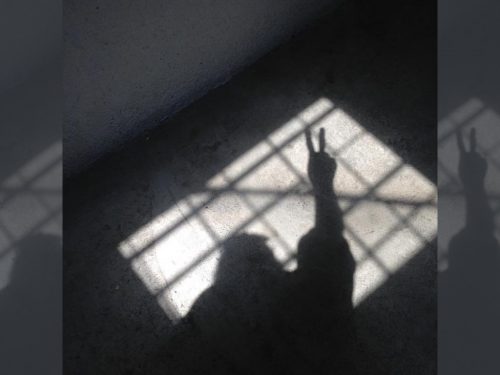
- Special Sections
- Year of Mercy
- YOM Online Lessons
Visit the Imprisoned
Online Lesson: These online lessons may be used: • by individuals anytime, anywhere. • in group settings — families, faith sharing groups, faith formation programs, and schools. • in “flipped” classroom situations for people to view before meeting face to face. You may just want to use a suggested video, story, or question — in anyway that helps us recognize that God’s mercy is anytime, anywhere, and we are called to be merciful as well. The structure of the lesson is based on Msgr. Francis Kelly’s Ecclesial Method .
Step 1 – Preparation: Each lesson will begin with a video and prayer to help us focus on the Works of Mercy in General.
Works of Mercy Reflection:
Merciful God,
You have created us to love You with all our heart, with all our soul, and with all our mind and to love our neighbor as ourselves . Yet we are often imprisoned in some way that prevents us from being as loving as we should be. Keep us mindful of those of us who are imprisoned physically, spiritually and psychologically. Give us the strength to reach out to those who are shackled in some way, and the courage to be open to those who call us to a freedom from our own bonds.
Step 2 – Proclamation: Each lesson will repeat the Works of Mercy to help us remember them.
The Spiritual Works of Mercy :
The Spiritual Works of mercy are acts of compassion, as listed below, by which we help our neighbors with their emotional and spiritual needs.
Counsel the doubtful Instruct the ignorant Admonish sinners Comfort the afflicted Forgive all offenses/injury Bear wrongs patiently Pray for the living and the dead
The Corporal Works of Mercy :
The Corporal Works of mercy are these kind acts by which we help our neighbors with their material and physical needs.
Shelter the homeless/Welcome the stranger Feed the hungry Give drink to the thirsty Clothe the naked Visit the sick Visit the imprisoned Bury the dead
Step 3 – Explanation: This step will address a specific Work of Mercy.
This Month: Visit the Imprisoned
All of the Works of Mercy boil down to this: “Beloved, if God so loved us, we also must love one another. (1 Jn 4:11)”
The Works of Mercy provide ways in which we can love better. The common theme throughout them is the continuance of our journey from self-centeredness to other-centeredness. The Reign of God is made more present as we are more attentive to others in their needs.
Visiting the Literally Imprisoned
Visiting the Imprisoned is a very challenging work in our culture. Below we will explore imprisonment metaphorically, but literal imprisonment deserves attention as well. In his blog, As I See It , Msgr. Vincent Rush posts:
This Holy Work has changed its meaning over time. The first Christians were, as you know, outlaws; so it was expected that some of their number would be in prison at any given time. Jesus was a prisoner; Paul was; Peter was; and many of the saints, bishops, and teachers of the first few centuries of Christian life were. So free Christians took it upon themselves to visit their friends, bringing food, solace, encouragement, and when possible liberation. They also sought the prisoners’ blessing, since to be imprisoned for being a Christian was a mark of great courage and faith. These days things are different, at least in our part of the world. (Christians continue to be imprisoned and even executed for their faith in the Middle East, in China, in Pakistan, in North Korea and in other countries.) People in prison are there as the result of a judgment by a criminal-justice system that, while by no means perfect, does make them different from the Christian prisoners of Jesus’ day. And modern prisons are not, by and large, visit-able places. So how are we to understand this Holy Work today? We might start by remembering that even the prisoner guilty of the most awful crime is still created in God’s image and is loved by God no less than God loves you or me. -Fr. Vincent Rush The Corporal Works of Mercy (4): To Visit the Imprisoned
Nothing helps us understand someone else better than a story. Karen Imholte shares a little of her story as an educator in the prison system, and a little bit of a story of one of her students. With a little tough love, Karen (and his Grandmother) empowered him to take a college level course that changed his life.
Along with the protection of society from truly dangerous individuals, one goal of imprisonment should always be rehabilitation so that the “lost” can be “found” and restored to a right relationship with God and others. But this costs money – for addiction treatment, for education, and for other aids to rehabilitation that are too-easily disposed of in times of budget cuts. And these programs do serve both society and prisoners – a recent study from California showed that both incarceration rates and crime dropped as rehabilitation increased. [1] -Fr. Vincent Rush The Corporal Works of Mercy (4): To Visit the Imprisoned
We are all victims of the deeds of criminals, even if it is just the climate of fear we experience when humans are violated. But how are we engaged with initiatives that make crime less likely to happen? This is a case where we cannot really change anyone but ourselves. How do we change ourselves and our system to affect positive change in others? Can we, in a sense, walk with ‘criminals’ by being proactively engaged in activities that prevent their crimes from ever happening in the first place?
Educating ourselves about the facts of imprisonment in the U.S. is a good step. Again from Fr. Vin:
The population of state and federal prisons grew by over 600% between 1972 and 1998; We imprison only a slightly lower proportion of our population than Russia, which has the highest rate in the world (we’re #2); Half of all inmates are African-American; one out of every three young African-American males is in prison, on probation, or on parole; Between 1970 and 1996 the number of women in U.S. prisons grew from about 5,600 to almost 75,000, a thirteenfold increase; most of these women were arrested for nonviolent crimes. [2] The U.S. bishops have called for reform. Their analysis and proposals are available on the web [note: their section on mission is digested below] . [3] We have to be careful not to allow our thinking about prison and prisoners (when we think about them at all) to be influenced by scaremongering to win votes (a not-unknown political phenomenon). -Fr. Vincent Rush The Corporal Works of Mercy (4): To Visit the Imprisoned
The analysis and proposals of the U.S. Bishops includes a section on the mission of the Church. How are we sent forth to address and act on this issue? Here is an encapsulation:
1. Teach right from wrong, respect for life and the law, forgiveness and mercy
“. … Catholic institutions that offer programs for youth and young adult ministry—including Catholic schools, Catholic Charities, and St. Vincent De Paul agencies—are bulwarks against crime, by providing formation for young people, enrichment and training for parents, counseling and alternatives for troubled children and families, and rehabilitative services for former inmates. ”
2. Stand with victims and their families
“. …Pastors and parish ministers must be prepared to respond quickly and effectively.
3. Reach out to offenders and their families, advocate for more treatment, and provide for the pastoral needs of all involved
“. … We know that faith has a transforming effect on all our lives. Therefore, rehabilitation and restoration must include the spiritual dimension of healing and hope. ”
4. Build community
“. … The Catholic Campaign for Human Development supports many creative efforts to prevent crime and rebuild community. ”
5. Advocate policies that help reduce violence, protect the innocent, involve the victims, and offer real alternatives to crime
“. … We must advocate on behalf of those most vulnerable to crime (the young and the elderly), ensure community safety, and attack the leading contributors to crime, which include the breakdown of family life, poverty, the proliferation of handguns, drug and alcohol addiction, and the pervasive culture of violence.”
6. Organize diocesan and state consultations
“. … We encourage diocesan leaders to convene similar processes of engagement and dialogue with those involved in the system: crime victims, former inmates, jail chaplains, judges, police officers, community leaders, prosecutors, families of victims and offenders, and others.”
7. Work for new approaches
“. … We also hope many others will join with them in efforts to prevent crime, reach out to victims, offer ministry and rehabilitation in our prisons, help to re-integrate ex-offenders, and advocate for new approaches.”
Visiting the Metaphorically Imprisoned
Fr. Vin concludes:
We can also extend the meaning of the Holy Work to consider those who are imprisoned metaphorically in other places: the elderly isolated in nursing-homes (or their own homes); people imprisoned by their addictions or their fears or their ignorance; people imprisoned by others’ views of them (immigrants, non-English speakers, people with disabilities…) The Holy Work of visiting the imprisoned can be as simple as a welcome that breaks down the wall of mistrust. That, each of us has opportunities to do every day. Until next week, peace Fr. Vin Rush Pastor’s Parish Blog “ As I See It “
Although the concept of using “visiting the imprisoned” as a metaphor is probably more comfortable to many of us than the issue literally taken, the challenges are formidable indeed. It is as simple… and as deep and demanding… as love. It is about making present the Reign of God that Jesus proclaimed. And he knew what it took.
Step 4 – Application and Appropriation into Life is the bridge between head knowledge and daily living as a disciple of Christ.
Faith in Action:
How do we reflect God’s love to those in prison? One formal initiative taken on locally is the Central Minnesota Residents Encounter Christ (REC) effort. It is a three part retreat over two days that invites participants to die with Christ, rise with Christ, and go forth to spread the Good News.
Reflection Questions:
Have you, or someone you know, ever spent time in prison? What did “visiting the imprisoned” mean at that time?
List some ways people are metaphorically imprisoned. What does “visiting the imprisoned” mean in those cases?
What are proactive ways we can change ourselves, and therefore our society, to prevent imprisonment from happening?
Suggested Activities (add your suggestions below):
- Call your local jail/prison to ask if it is appropriate to donate some Bibles to inmates. Ask about creating bookmarks with verses of encouragement.
Parish and School:
- Study statistics about the relationship between poverty and both literal and metaphorical imprisonment. Pray specifically for the imprisoned and their families as your students work on your next clothing, food or toy drive.
Step 5 – Celebration: Lessons will close with a prayer, silent or communally, that gives glory to God.
Closing Prayer:
Tender God,
You have created all of us in Your image, even those who are at the margins of society. Give us Your Spirit of Love that, as a Communion, we will create a culture in which no one would choose a path leading to imprisonment. Give us Your Spirit of Courage to find ways of walking with others, even outside of our comfort zones. Remind us that, in helping to make Your kingdom present, we must attend to those who are vulnerable in many ways as we pray the words Your Son gave to us:
Our Father, who art in heaven, hallowed be Thy name; Thy kingdom come; Thy will be done on earth as it is in heaven. Give us this day our daily bread;
and forgive us our trespasses as we forgive those who trespass against us;
and lead us not into temptation, but deliver us from evil. Amen.
In the “Leave a Reply” area below, please suggest another activity people could do to address this Work of Mercy , share a story about someone who visits the imprisoned, or write your own prayer for people in such need.
Author: Kristi Anderson
Kristi Anderson is the editor of The Central Minnesota Catholic Magazine for the Diocese of St. Cloud.
Leave a Reply Cancel reply
Save my name, email, and website in this browser for the next time I comment.
EWTN News, Inc. is the world’s largest Catholic news organization, comprised of television, radio, print and digital media outlets, dedicated to reporting the truth in light of the Gospel and the Catholic Church.
- National Catholic Register
- News Agencies
- Catholic News Agency
- CNA Deutsch
- ACI Afrique
- ACI Digital
- Digital Media
- ChurchPOP Español
- ChurchPOP Italiano
- ChurchPOP Português
- EWTN News Indepth
- EWTN News Nightly
- EWTN Noticias
- EWTN Pro-life Weekly
- Register Radio
Get HALF OFF the Register!
National Catholic Register News https://www.ncregister.com/blog/6th-corporal-work-of-mercy-visit-the-imprisoned

- Synod on Synodality
- Most Popular
- Publisher’s Note
- College Guide
- Commentaries
- Culture of Life
- Arts & Entertainment
- Publisher's Note
- Letters to the Editor
- Support the Register
- Print subscriptions
- E-Newsletter Sign-up
- EWTN Religious Catalogue
6th Corporal Work of Mercy: Visit the Imprisoned

The next corporal work of mercy includes two separate acts: “ransoming the captive” and “visiting the imprisoned.” For the purposes of this article we will look at “visiting the imprisoned” as that is a bit more accessible for the average person.
In my last article we looked at a recent pope, John Paul II, and his practice of “visiting the sick.” This week I decided to continue that trend and look at another recent pope who has made this work of mercy (visiting the imprisoned) a hallmark of his pontificate. As you may have guessed, it is none other than Pope Francis.
Loving Without Limits
It has become routine for Pope Francis to visit those in prison. On Holy Thursday he makes it a priority to celebrate Mass at a local prison, going so far as to wash the feet of the inmates there. This is not something new for Pope Francis, as he often visited the imprisoned as a bishop.
Even during his apostolic trips outside of Rome, Pope Francis has made it a part of his schedule to visit prisons. When he visited Philadelphia he stopped at the Curran-Fromhold Correctional Facility , gave a short sermon and shook hands with inmates.
During one of his recent homilies on Holy Thursday, Pope Francis addressed the prisoners and said:
“Jesus loves us, without limits, always, until the end. The love of God for us doesn't have limits. There is always more, always more. He never tires of loving anyone.”
It is clear that Pope Francis’ mission is to show to these souls that God still loves them and beckons them to reform their ways. Pope Francis is reaching out to these men and women who have made many bad choices in their life and is trying to instill hope in their hearts.
It is easy for prisoners to lose hope and turn inward upon themselves. They believe that they can never be “good” or break the cycle of sin. For many of them, it appears that God has abandoned them and does not know of their suffering.
Pope Francis realizes this state of mind and takes care not to forget these men and women, who are so often neglected. He reminds us that they have souls too and deserve our time and attention.
Prison ministry is a beautiful way of participating in this work of mercy, but is certainly not for everyone. It takes “tough skin” to encounter prisoners and is not easy. This does not mean we should not carefully discern if God is calling us to visit the imprisoned. It is very much needed in today’s world, especially in this year of Mercy.
Another way that we can participate in this work of mercy is to imitate Saint Thérèse of Lisieux. Before she entered the convent Saint Thérèse learned about a criminal sentenced to death and decided to fervently pray for his conversion. Here is how she describes it in Story of a Soul :
“Just then I heard much talk of a notorious criminal, Pranzini, who was sentenced to death for several shocking murders, and, as he was quite impenitent…How I longed to avert this irreparable calamity! In order to do so I employed all the spiritual means I could think of, and, knowing that my own efforts were unavailing, I offered for his pardon the infinite merits of Our Savior and the treasures of Holy Church…I said in all simplicity: ‘My God, I am quite sure that Thou wilt pardon this unhappy Pranzini. I should still think so if he did not confess his sins or give any sign of sorrow, because I have such confidence in Thy unbounded Mercy; but this is my first sinner, and therefore I beg for just one sign of repentance to reassure me.’ My prayer was granted to the letter…The day after his execution I hastily opened the paper, La Croix, and what did I see? … Pranzini had mounted the scaffold without confessing or receiving absolution, and the executioners were already dragging him towards the fatal block, when all at once, apparently in answer to a sudden inspiration, he turned round, seized the crucifix which the Priest was offering to him, and kissed Our Lord's Sacred Wounds three times.”
We must not forget the imprisoned or treat them like refuse to be thrown away. God loves them and He desires their salvation. Let us discern in this year of Mercy how we can practice this much needed corporal work of mercy.
Philip Kosloski Philip Kosloski graduated from the University of Saint Thomas in Minnesota with a Bachelor’s in Philosophy and Catholic Studies and completed his Master of Arts degree in Theology with the Augustine Institute. He is a writer and author of In the Footsteps of a Saint: John Paul II's Visit to Wisconsin . He blogs at philipkosloski.com and writes to help all Catholics master the art of prayer by conquering the practical obstacles that prevent a fruitful relationship with Christ.
- Related Stories
- Latest News

How Writing a Spiritual Autobiography Unveiled My Path Home
‘Not in this life, it is true, but only in eternity will God be all in all, yet even now he dwells, whole and undivided, in his temple the Church.’ —Pope St. Leo the Great

Pope Francis to Meet With Thousands of Grandparents and Their Grandchildren at the Vatican
A total of 6,000 faithful will arrive this week for a special gathering with the Holy Father.

‘I’m a Witness to Unspeakable Suffering’: Ethiopia Bishop Wants Peace Pact Implemented
Violent conflict in the Tigray region started in November 2020 when TPLF allegedly launched an attack on Ethiopia’s Federal Government Army base in the region.

Experts and Former Abortionist Warn About ‘Eugenic’ IVF Industry
According to Bruchalski, the IVF industry operates like the “Wild West,” with little to no oversight.

5 Times Jesus Revealed Himself in the Eucharist to Non-Catholics
‘And it happened that, while he was with them at table, he took bread, said the blessing, broke it, and gave it to them. With that their eyes were opened and they recognized him, but he vanished from their sight.’ (Luke 24:30-31)

My Near-Death Experience and Miraculous Healing, and More Great Links!
The Best In Catholic Blogging

Mainstream Media Ignores the Very Heart of ‘Dignitas Infinita’
Much in this document deserves pondering. Too bad readers of certain news outlets wouldn’t know that.
Meet the Women Defying the ‘Birth Dearth’
Pew research: biden in trouble with catholic voters, abortion, social media, guns: supreme court poised to impact religious freedom, nuns who feuded with texas bishop say they will defy vatican order on monastery’s governance, the subway to the sacred: brooklyn’s breathtaking eucharistic revival, ‘the habsburg way’: lessons for today, from openness to life to how to die well, 5 catholic ways to celebrate earth day, pope francis: christ the good shepherd ‘looks for us until he finds us’ when we’re lost, subscription options.

Subscriber Service Center Already a subscriber? Renew or manage your subscription here .
Subscribe and Save HALF OFF! Start your Register subscription today.
Give a Gift Subscription Bless friends, family or clergy with a gift of the Register.
Order Bulk Subscriptions Get a discount on 6 or more copies sent to your parish, organization or school.
Sign-up for E-Newsletter Get Register Updates sent daily or weeklyto your inbox.
Confraternity of Our Lady of Mercy
Women and Men Seeking Holiness as the Answer to Abortion
Corporal Works of Mercy: Visit the Imprisoned
October 1, 2015 by Fr. Ben Cameron Leave a Comment
The fifth Corporal Work of Mercy is “Visit the Imprisoned.” This work of mercy is important, and often neglected.
When I was in college, I had the privilege of being involved in the Legion of Mary, a Catholic lay apostolate that began in Ireland, that involves a commitment of two hours of apostolic work done each week, always with a partner (which is great, so that you are never alone on an assignment). One of the works that we did was that a group of the young men would visit a local state prison every week. While there, we would visit with the prisoners in the dining hall, talk to them about the Bible and our Catholic Faith, answer their questions, and, sometimes, help them with preparation for the sacraments. One of my greatest joys was to see a man who I had worked with for several months when he came out from making his first confession since early childhood — he could have leaped through the roof of the prison, he was so filled with joy!
Not all of us can visit prisons, at least not “prisons” as we normally think of them. But do we have a family member or an old friend who might be in jail or prison? Could we visit that person, or at least write to them, so that they know that they are not forgotten?
In addition to normal prisons, there are many people who are “prisoners” to addictions: could we reach out to them with the Love of the Lord Jesus Christ? Could we help them to know that Freedom is available, if they will seek out the help that they need? What about elderly or disabled persons who are “prisoners” in their own homes — could we visit and comfort them? Find some way to serve them in their time of need, and let them know that they are still remembered and loved?
When it comes to “visit the imprisoned,” maybe the most important thing to remember is that we do not approach them out of purely human (“humanitarian”) feelings. No, as Christians, we approach the imprisoned (of whatever kind of prison it might be) with the Love of Jesus in our hearts, to love and serve Jesus who is suffering in that person. That is the spirit of loving service that we saw in Mother Teresa of Calcutta, and that is the spirit in which we should approach the imprisoned.
Leave a Reply Cancel reply
Your email address will not be published. Required fields are marked *
Save my name, email, and website in this browser for the next time I comment.
This site uses Akismet to reduce spam. Learn how your comment data is processed .
- Testimony from a Woman Healed from Abortion
- The Power of God's Mercy to Heal even the Deepest Wounds
- Women of Grace: Part one of interview with Fr. Ben Cameron
Devotional Links
- Chaplet of Divine Mercy
- How to Pray the Rosary
- Miraculous Medal
- The Green Scapular
Post-abortion healing
- Entering Canaan Retreats
- Hope After Abortion – Project Rachel
- Rachel's Vineyard – International Site
- Rachel's Vineyard Kentucky
- Rachel's Vineyard Kentucky Facebook page
- Fathers of Mercy
Posts: Listed by Topics
- Art in Honor of the Unborn (2)
- Latest News (32)
- Liturgical Prayers (3)
- Prayer requests (1)
- Radio/TV interviews (4)
- Reflections from Saints and Holy Persons (34)
- Spiritual Teaching (83)
- Testimonies (4)
- Uncategorized (5)
- Works of Mercy (18)
Post Archives: By Month

Sixth corporal work of mercy: Visiting the imprisoned
God calls the faithful to show mercy to those physically, mentally in prison.
By Marge Fenelon Catholic News Service
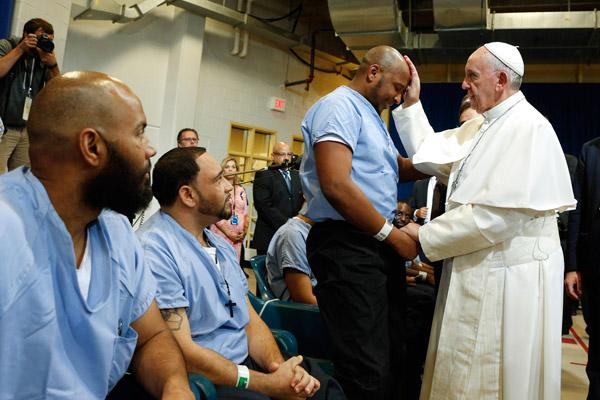
During this Year of Mercy instituted by Pope Francis, we’re called to become extensions of God’s mercy to others, particularly through the spiritual and corporal works of mercy — acts of charity and love toward others.
But one corporal work of mercy may prove a bit more challenging to carry out — visiting the imprisoned. How are we supposed to visit the imprisoned?
No doubt, it’s important to visit prisoners. They need and deserve Christian love and charity as much as anyone else. But there are different ways to be imprisoned. Just as there are physical bars that keep us locked in, there are mental, emotional and spiritual walls that keep us locked in as well.
Fears, anxiety, depression and hopelessness are all “prisons” that hold us captive, keeping us from feeling the love of God. They cage us in, stopping us from becoming children of God and from becoming the person he intended us to be. We may not have committed a crime per se, but we are incarcerated just the same.
Our Lord had compassion for those imprisoned by invisible walls as well as those imprisoned by real walls. There are numerous examples in Scripture, but the one that comes to mind is the story of the Gerasene demoniac (Mark 5:1-20) cured of his affliction and released from his cell by Jesus.
Jesus and his disciples had crossed the Sea of Galilee and entered Gerasa. There, he found a man who had long been tormented by demons and lived among the tombs. No manner of restraint could keep him from causing harm to himself or to others. The people of Gerasa feared him.
Amid the man’s shrieks, Jesus commanded the demons to leave him. At their request, Jesus sent the demons into a nearby swineherd. The swine then ran to the edge of a high cliff and jumped off, falling into the water and drowning. Only then, the man was again in his right mind and made capable of living a normal, productive life.
The Gerasene man had been imprisoned by demons, kept in a jail of torment that prohibited him from living a life of love and fruitfulness with family and friends. Jesus visited him in this prison, so to speak, by seeing him, not as he was, but as he could and should be: a free and joyful child of God.
So, too, should we see and help those who are imprisoned by a variety of walls. We should see them, not as they are, but for what they should and can be: free and joyful children of God. They need us to visit them in their prisons and to minister to them with compassion.
We may not be able to cure them of their torment, as Jesus did with the Gerasene man, but we can be for them a reflection of the light in their darkness.
Please read our Comments Policy before posting.

Related Articles
Current news, news & views from you, from the bishop.
Join Us on Facebook | Follow Us on Twitter | Privacy and Terms of Use | View and Buy Photos | Advertise | About Us
© 2024 Arkansas Catholic | 2500 N. Tyler St., Little Rock, AR 72207 | (501) 664-0125
The Magazine of the Catholic Diocese of San Jose

Corporal Works of Mercy
Share this story.


How Can Families Practice the Works of Mercy? - Visit the Imprisoned
“I was hungry and you gave me food, I was thirsty and you gave me drink, a stranger and you welcomed me, naked and you clothed me, ill and you cared for me, in prison and you visited me.”
Jesus’ powerful words in the Gospel of Matthew form the basis for the traditional list of the works of mercy. When it comes to meeting physical needs, the Compendium to the Catechism of the Catholic Church lists the following actions as the corporal works of mercy:
- Feed the hungry
- Give drink to the thirsty
- Clothe the naked
- Shelter the homeless
- Visit the sick
Visit the imprisoned
- Bury the dead
How can families live this out? Especially with young children, hands-on charitable work can be daunting, but not impossible. The works of mercy will look different for each family – and can be practiced very literally when it comes to caring for children! But if you have a desire to introduce your children to acts of charity outside the home, I hope these ideas can be a gentle nudge to step out as the domestic Church and seek encounters with those in need.
As with “burying the dead,” visiting the imprisoned might seem, at first glance, a work of mercy that’s out of reach for most families. How is that supposed to work with young children?
Let’s back up and think about aspects of our society that can create isolation, loneliness and even a feeling of imprisonment. Even before the COVID-19 pandemic, the “loneliness epidemic” was being acknowledged, and studies continue to confirm its prevalence, including among young adults and parents of young children. We could go on for pages about the causes, but in the end, chances are high that someone near us feels miserably alone – even in the busyness of family life.
I’ve seen this in mothers who love their babies and are grateful to be able to stay home with them, but feel like their only interaction with adults comes through their smartphones. For others, isolation might come in the form of a diagnosis or disability that impedes routines and socializing. When it’s difficult to leave the house or commit to invitations for any reason, loneliness can creep in, and even the most loving home can feel confining. A single parent juggling the roles of two; someone with a spouse on military deployment or working irregular hours – these are situations not uncommon to our experience as families, and they can all contribute to people losing connections and chances for friendship. How can we remain sensitive to these needs? When friends might feel constrained by their current circumstances, are we willing to go to them, and to keep offering our friendship?
And while visiting literally incarcerated people isn’t possible for most families, writing letters is. One place to start would be a diocesan prison ministry, if they’re equipped to set up volunteers with an incarcerated pen pal. Another option is the Order of Malta Pen Pal Program (orderofmaltafederal.org/prison-minsitry), which enrolls volunteers from across the country.
I can understand why some families might hesitate at the thought of involving their children. Is it safe? What would you even write about?
To the first point, I’ll say that every program I’ve encountered takes great pains to protect letter writers’ privacy – and to make sure you know how to maintain an appropriate relationship with your pen pal. As to the second question, I asked a friend who has done this for many years, and she pointed out that many prisoners are estranged from their own families. Having communication coming from the heart of family life can be deeply meaningful.
If you’re looking for a practice to take up this Lent, consider whether writing letters to incarcerated people might be a work of mercy for your family. Regardless of how you practice visiting the imprisoned, may you and your family bring the light of Jesus into some of the dark, lonely corners of your world.
Elizabeth Hansen and her husband, Luke, raise their four children in Lansing, where they attend Resurrection Parish.
¡Lee este artículo en español! (Spanish Language Version)
Related stories.

How can families practice the works of mercy? - Give drink to the thirsty

How Can Families Practice the Works of Mercy? - Shelter the Homeless

How Can Families Practice the Works of Mercy? - Visit the Sick
The Catholic Diocese of St. Petersburg
Share this story
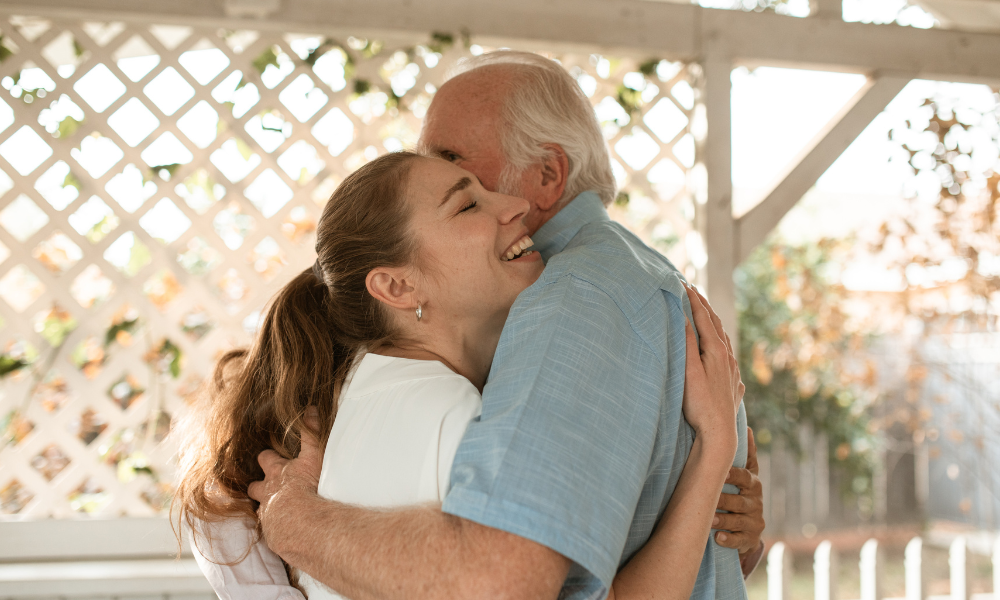
How Can Families Practice the Works of Mercy? - Visit the Imprisoned
March 14, 2023 | “i was hungry and you gave me food, i was thirsty and you gave me drink, a stranger and you welcomed me, naked and you clothed me, ill and you cared for me, in prison and you visited me.”.
Jesus’ powerful words in the Gospel of Matthew form the basis for the traditional list of the works of mercy. When it comes to meeting physical needs, the Compendium to the Catechism of the Catholic Church lists the following actions as the corporal works of mercy:
- Feed the hungry
- Give drink to the thirsty
- Clothe the naked
- Shelter the homeless
- Visit the sick
Visit the imprisoned
- Bury the dead
How can families live this out? Especially with young children, hands-on charitable work can be daunting, but not impossible. The works of mercy will look different for each family – and can be practiced very literally when it comes to caring for children! But if you have a desire to introduce your children to acts of charity outside the home, I hope these ideas can be a gentle nudge to step out as the domestic Church and seek encounters with those in need.
As with “burying the dead,” visiting the imprisoned might seem, at first glance, a work of mercy that’s out of reach for most families. How is that supposed to work with young children?
Let’s back up and think about aspects of our society that can create isolation, loneliness and even a feeling of imprisonment. Even before the COVID-19 pandemic, the “loneliness epidemic” was being acknowledged, and studies continue to confirm its prevalence, including among young adults and parents of young children. We could go on for pages about the causes, but in the end, chances are high that someone near us feels miserably alone – even in the busyness of family life.
I’ve seen this in mothers who love their babies and are grateful to be able to stay home with them, but feel like their only interaction with adults comes through their smartphones. For others, isolation might come in the form of a diagnosis or disability that impedes routines and socializing. When it’s difficult to leave the house or commit to invitations for any reason, loneliness can creep in, and even the most loving home can feel confining. A single parent juggling the roles of two; someone with a spouse on military deployment or working irregular hours – these are situations not uncommon to our experience as families, and they can all contribute to people losing connections and chances for friendship. How can we remain sensitive to these needs? When friends might feel constrained by their current circumstances, are we willing to go to them, and to keep offering our friendship?
And while visiting literally incarcerated people isn’t possible for most families, writing letters is. One place to start would be a diocesan prison ministry, if they’re equipped to set up volunteers with an incarcerated pen pal. Another option is the Order of Malta Pen Pal Program (orderofmaltafederal.org/prison-minsitry), which enrolls volunteers from across the country.
I can understand why some families might hesitate at the thought of involving their children. Is it safe? What would you even write about?
To the first point, I’ll say that every program I’ve encountered takes great pains to protect letter writers’ privacy – and to make sure you know how to maintain an appropriate relationship with your pen pal. As to the second question, I asked a friend who has done this for many years, and she pointed out that many prisoners are estranged from their own families. Having communication coming from the heart of family life can be deeply meaningful.
If you’re looking for a practice to take up this Lent, consider whether writing letters to incarcerated people might be a work of mercy for your family. Regardless of how you practice visiting the imprisoned, may you and your family bring the light of Jesus into some of the dark, lonely corners of your world.
Elizabeth Hansen and her husband, Luke, raise their four children in Lansing, where they attend Resurrection Parish.
Related Stories

Over-protecting or keeping kids safe?

Over-protecting or just keeping kids safe?
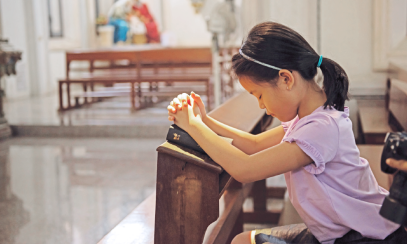
Helping Hesitant Kids Go To Confession
To Visit the Imprisoned
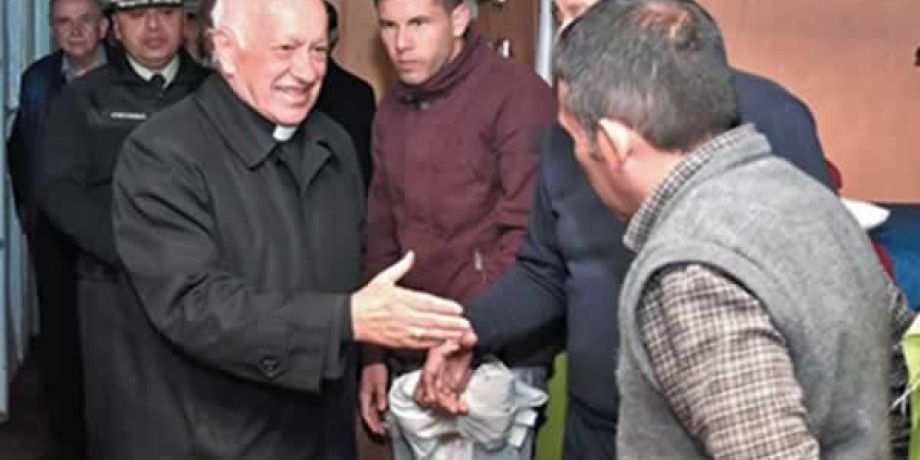
Celebrating the Year of Mercy
Fr. Michael J. Hoban
Pope Francis continually reminds us that the Church is missionary and is called to reach out to the poor, to sinners, to unbelievers and to those who live on the margins of modern society. In 2016 Pope Francis called the Church to celebrate a Year of Mercy and to discover once again the importance of the spiritual and corporal works of mercy. The Jubilee Year of Mercy was a unique opportunity for the Church in Chile to be missionary and to reach out to those who feel that there is no place for them in society.
The Archdiocese of Santiago is divided into seven territorial vicariates. The most recent vicariate to be established in the Archdiocese of Santiago is the Vicaria del Maipo (Maipo Vicariate) where I am privileged to be the Episcopal Vicar. Our Vicariate is located on the southern outskirts of the sprawling city of Santiago and includes two very different municipalities: Puente Alto (the most populated municipality in the country) and San José del Maipo (a rural municipality nestled in a canyon of the Andes Mountains). Our Archbishop, Cardinal Ricardo Ezzati invited each Vicariate of the Archdiocese to emphasize one of the corporal works of mercy and to implement that particular work of mercy in a special way. The priests, Sisters, deacons and lay pastoral agents of the Vicariate of Maipo decided that we were called to live out the corporal work of mercy: to visit the imprisoned.
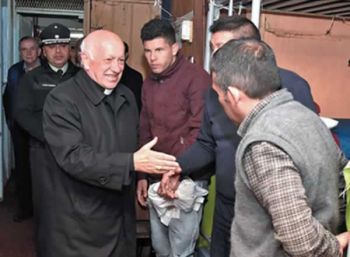
We based our decision on the fact that Puente Alto has a prison with 1300 male inmates. It was built to house 700 inmates. With nearly double the number of inmates for which the prison was designed, the men are condemned to live in overcrowded conditions in large dormitories with bunk beds. Each bunk bed has mattresses for three men. The man on the top can touch the ceiling with his nose! The food rations provided by the prison authorities leave a lot to be desired, and so the inmates rely on their families to bring them food which they cook and share among themselves. Many of the inmates come from the Columban parishes of San Matías and Santo Tomás.
When I returned to the Maipo Vicariate after four years as the Episcopal Vicar of the Southern Zone, I brought with me a frightening memory. On December 8, 2010, the feast of the Immaculate Conception, there was a fire in the San Miguel prison and 81 inmates were burnt to death. It was caused by a fight among the inmates. Some of the prisoners had built a flame thrower using the gas canisters of their little kitchen. The flames ignited mattresses. The fire was so intense that the gates of the prison cell could not be opened. I went to the prison and spent the day consoling families who had lost their sons, husbands or brothers to the fire. I went with Cardinal Francisco Javier Errazuriz to the area of the prison where the charred bodies of the dead prisoners were being kept. Cardinal Errazuriz prayed for the dead and blessed the bodies of the victims of the fire. After that experience, I could not ignore any longer the plight of the men and women who are deprived of their liberty for the crimes which they committed. As Pope Francis teaches us, no matter what sins we may commit we are never excluded from the love or the mercy of God.
Not long after returning, I visited the prison in Puente Alto. I discovered that a small group of Catholics were visiting the prison every Wednesday. I met with them and we began to explore ways of increasing the number of pastoral agents for this apostolate. Then the merciful Lord sent us a great blessing. A new chaplain was appointed to the prison, Fr. Armando. Padre Armando is a native of Iquique in northern Chile, and in his youth he participated actively in the Columban parish of Espíritu Santo. Fr. Armando proudly claims that he owes his vocation to Columban Father Hugh McGonagle who accompanied him in his discernment about the priesthood while he was in the seminary and in his early years as a priest.
Together with Fr. Armando, the Vicariate of Maipo organized workshops and courses on prison apostolate increasing the number of lay pastoral visitors from seven to 30. The increase in volunteers has meant that four days a week Catholic prisoners can avail of spiritual accompaniment and prayer. When Fr. Armando arrived in Puente Alto, the small Catholic chapel was in deplorable condition. The Maipo Vicariate made a commitment to raise funds to repair and renovate the prison chapel. So far we have raised more than $600,000 pesos (around $850.00 U.S.) for the renovation. On August 12, 2016, Cardinal Ricardo Ezzati visited the prison and celebrated the Eucharist for the prisoners. He also blessed the chapel's new tabernacle which was donated by the Apostolic Works of Ennis, Co. Clare in Ireland. Cardinal Ezzati called on the inmates not to lose heart nor lose the faith: "I want to encourage each one of you to develop all your abilities so that you can become new men, so that you can live happily with your families. Believe firmly that God can give you that possibility."
During the same month of August, we organized a campaign in our parishes to donate toiletries for personal use: toothpaste, toothbrushes, soap, toilet paper, shampoo etc. In all our parishes there was a generous response. I joked with Fr. Armando that his inmates have the cleanest hair and the whitest teeth in Chile!
In September, a religious sister of St. Ann, Sister Maria Luz Treupil, came to our Vicariate to work in prison ministry. She had spent many years in this ministry in the prison of the northern city of Antofagasta. While she was there, she began a choir and taught some of the younger inmates to play the guitar. Eventually, they produced a CD. Sr. Maria Luz hopes to repeat that experience in Puente Alto. On December 19, we organized a Christmas party for the inmates who regularly attend Mass together with members of their families. Finally, for the first time ever in the pastoral life of our Vicariate, the Summer School for the Laity will offer two courses in the prison for the men.
As the Jubilee Year of Mercy came to an end, Pope Francis wrote a Pastoral Letter, "Misericordia et Miseria." There is no doubt that prisons are necessary in society but we also need to remember: "No law or precept can prevent God from once more embracing the son (daughter) who returns to him, admitting that he has done wrong but intending to start his (her) life anew." ("Misericordia et Miseria" no.11)
Columban Fr. Michael J. Hoban lives and works in Santiago, Chile.

- Ministry Resources
Charity, Justice, and Mass Incarceration: How Visiting the Imprisoned Changed Me
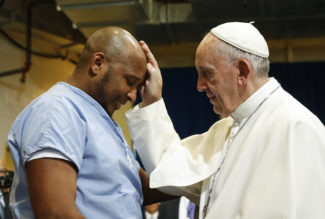
Some things didn’t surprise me during my first visit to a state correctional facility in 2011. When I got involved with Partakers , a College Behind Bars mentoring program that pairs volunteers with incarcerated men and women working on a college degree, the program coordinator gave me plenty of advice: Leave your jewelry at home — you’re not going to like the look of the lockers. Wear a sports bra — the metal detectors are on steroids, and if they go off, you’re going home. And don’t make any plans for the rest of the day — the lines move at a snail’s pace.
Other aspects of my first visit defied expectations. Hollywood had led me to believe that I’d meet Tom, to whom I’d introduced myself via letter, in a visiting booth with a glass partition separating the two of us and that he’d be wearing an orange jumpsuit. Instead, all visitors gathered in a large, open room where we were met by men in blue jeans and white T-shirts. Tom greeted me with a warm, firm handshake, which was another surprise. I didn’t think that physical touch would be permitted, so I didn’t anticipate the messages silently conveyed in Tom’s confident, yet gentle, grip.
Though I don’t recall what exactly I expected of Tom, I clearly remember the sting of self-reproach as I was surprised by his handshake. Shame on me for having preconceived notions about a person I didn’t know merely because he was incarcerated. This was the first of many moments that I was stretched and grew through my relationship with Tom.
RELATED: Comfort the Mourning: 5 Tips for Writing a Meaningful Sympathy Note
Moments of encounter with another can be personally transformative, and that is one of the greatest blessings of putting the Corporal Works of Mercy — seven instructions based on the teachings of Jesus — into action. The works offer a clear path to honoring the dignity of all people, and they open us up to experiencing our shared humanity with our hungry, thirsty, sick, marginalized, vulnerable, and incarcerated brothers and sisters.
Like all the works of mercy, there are many ways to put visiting the imprisoned into action. Here are just a few:
Visit someone in prison
Numerous organizations coordinate relationships between volunteers and people behind bars. Pen America and Prison Fellowship are two examples, but a quick Google search will uncover other nonprofits in your area. Or find out if your church or diocese has a prison ministry . Alternatively, consider your own social networks: Do you know anyone, or do you know anyone who knows anyone, who is in jail or prison? If you worry that your visit may be unwelcome, send a letter of inquiry first.
Become a pen pal
If visiting isn’t possible, consider developing a pen pal relationship. Many people in prison, especially those on death row, have minimal contact with the outside world, and letters provide both longed-for news and human connection. Like visiting, you might start by writing to someone from your social network, or you can use a program like the Death Row Support Project to get connected. Before writing, visit the prison or jail’s website to read their rules and procedures, and also check out Mary Catherine Johnson’s tip sheet for letter writing. Although Johnson writes about her experience corresponding with someone on Georgia’s death row, she includes excellent general advice that is universally helpful.
RELATED: Catholic Social Teaching and Reducing Food Waste
Be part of criminal justice reform
You can also get involved with one of the many nonprofits working to reform our country’s broken criminal justice system through programming and advocacy. This could mean anything from offering financial support to filling numerous volunteer needs to getting the word out about the organization. Maybe you decide to host a book drive at your church for the Prison Book Program , knowing that education is proven to reduce recidivism rates . Or sign up to meet a newly released man or woman at the prison gates through the Ride Home Program with the knowledge that release can be an overwhelming and frightening time for the formerly incarcerated, and that they are at the highest risk for recidivism in their early days of freedom. Or answer hotline calls or fundraise for Freedom for Immigrants , an organization devoted to abolishing immigration detention. Any of these organizations would benefit from your time, talent, treasure, and dedication to honoring the humanity of people behind bars.
I’ve heard it said that charity and justice are the two feet of love in action : Charitable works respond to immediate needs and social justice addresses systemic, root causes of problems. I would contend that charity and justice are the caterpillar and butterfly of living out the Gospel message. Encounter with another through the Corporal Works of Mercy gives birth to personal transformation and a renewed hunger for justice. A desire to live charitably led me to Tom, and in turn, Tom led me to be challenged and changed. While I no longer visit Tom – he graduated from the program, and I moved away – I know that his graduation didn’t lead to his parole. My care for Tom and the 2.2 million others suffering under the weight of mass incarceration impacts my prayers, my decisions in the voting booth, how I talk about people behind bars, and my choices about charitable giving. Our encounter instilled in me a conviction that I must play a part in working for justice for all members of our shared humanity.
Have you joined our mailing list yet?
Sign up for weekly updates from Busted Halo!
- CM Hangouts
- Explore all stories
- Daily Prayers
- Sunday Gospel Activities
To Visit the Imprisoned
Sep 26, 2016 12:00:39 PM | by Roxane Salonen
It's a corporal work of mercy that, so often in my life, I've opted to sort of skirt around. I'm a mother, after all, and this means vigilance when it comes to my family. And so the thought of visiting the imprisoned has seemed something to avoid.
And yet, lately, God has very directly been tapping me. "Don't be so quick to bypass this one," I hear him saying.
So many things have gone into play which bear reflection and discernment. It started with a local woman who is passionate about a ministry our county has adapted called Jail Chaplains. My sister also has been involved in a similar ministry in her city in the central part of the state.
And then came the Jubilee Year of Mercy. While giving a talk on mercy, I welcomed comments from a priest, who shared about his involvement in Jail Chaplains. He spoke with such conviction that my heart began to expand, and wonder what my role could be.
Then, recently, I heard that our bishop offered Mass at our jail, and our parish put out a bulletin call for spiritual books that could be brought to the inmates. I also have learned that weekly Eucharist services are going to be added for both men and women behind bars in our city.
Each time I hear about the need for the imprisoned to be ministered to, I feel less inclined to run the other way. Though cautious still, I am at least open to the possibilities.
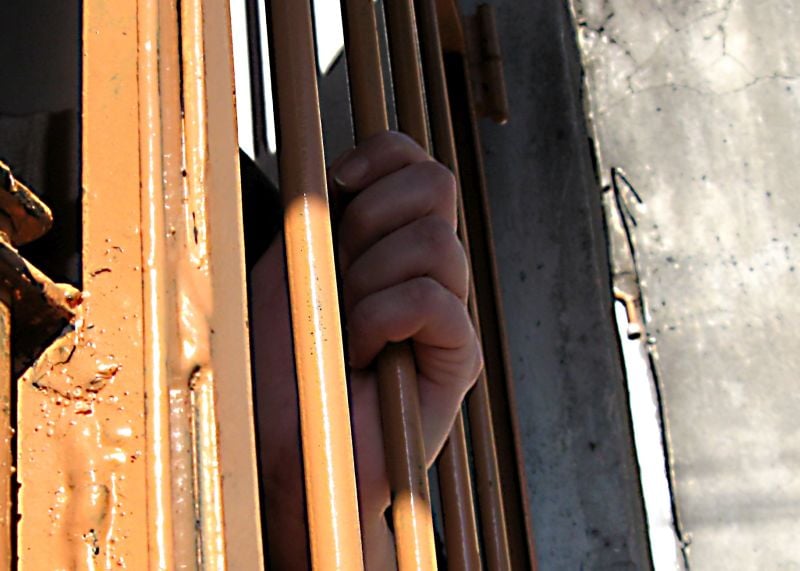
Recently, I had a chance to follow through on a Holy Spirit nudge when I was invited to have lunch at our county jail. We would hear a presentation about Jail Chaplains, eat the same lunch the inmates would be served, and listen to testimonies of former and current inmates, as well as one of the leaders of the program.
It was a step I'm grateful to have taken. Just being on the premise opened my eyes, and so many thoughts began stirring. Certainly, I felt more connected to those who reside within the concrete walls of the jail as I nibbled on a very basic sandwich and slurped down corn chowder, drinking water from a Styrofoam cup.
The former and current inmates who talked with us shared a little of their life stories. Both had been introduced to Christ early in their lives, but for whatever reason, it didn't stick, as with so many young people. Each, for fairly valid reasons, became disillusioned with life, and in time, turned to a life of crime, mostly entwined with drugs.
Addiction cannot be taken out of the equation. A large majority of the incarcerated are addicts, and as we know, addiction follows other ills in one's life, not because those individuals really enjoy the taste of their drug of choice.
I found the insight of the current inmate, who came into the room in his bright-orange garb, to be particularly revealing. Before he connected with Jail Chaplains, he said, time in jail was just a pause from one high to another; just a stall. He showed up at one of the Jail Chaplains meetings because of a promise of food. But something there grabbed him, something hopeful. And after a while, he says, he began "looking at people differently," noticing things around him he hadn't seen before. It was as if his frozen soul had begun to melt. Drop by drop, something new came into view. Now, seeing college on the horizon, he is grateful to have Christ back in his life.
By the time he got done talking, I saw him not as another inmate but a boy searching for God, desperate to make a better life for himself. Rather than scary, he seemed vulnerable, and certainly, his willingness to share his story touched me. He'd been a meth baby, so from that start, it seemed, was doomed. But no more.
A sheriff's deputy who has helped with the program shared that since its incorporation, tension within the jail has decreased significantly. For when people begin to understand that they have dignity, the need to fight against the world and everyone in it lessens.
Even as I'm absorbing all of this, I've been poring through Peter Kreeft's newest book, I Burned for Your Peace: Augustine's 'Confessions' Unpacked , which has me enthralled. And I've reached the point at which St. Augustine knows Truth, but is not quite ready to go all the way.
"And here I was going on thirty, still sticking in the same mire, greedy for the enjoyment of things present though they ever eluded me and wasted my soul, and at every moment saying, 'tomorrow I shall find it.'"
Oh, the ever elusive, "I will change...tomorrow."
These thoughts and others kept Augustine restless.
"Time was passing and I delayed to turn to the Lord. From day to day I postponed life in You, but I did not postpone the death that daily I was dying in myself."
But then comes the good news; news that can help us see what might be possible.
"Augustine's dissatisfaction with his own life was a necessary preliminary to his conversion," Kreeft notes. "Someone who is totally satisfied with his life is not going to convert, or marry, or join the army."
I pause, thinking of my illumination that day in the jail. Who is in a better position to hear about Christ than one who, at least for the moment, is clear-headed, with basic needs met, yet haunted by a past that has only led to discord and fragmentation? The incarcerated are perhaps most equipped to sit down and hear the story of a God-man who can make all things new.
[Tweet "Visiting the imprisoned reminds @peacegardenmama to consider how to serve those hungry for God."]
It's taken me a while to get here, but as a friend pointed out when my children were really small, the imprisoned can be the child in the crib, or the mother feeling isolated in her own home while caring for young, needy children. There are times in our life when staying put is the best thing of all -- and sometimes, the only possible thing. But there are other times God asks more of us. He bids us to come more closely into his heart to see more fully the needs around us, and to pray on how we might serve him through serving those hungry for his love.
I don't know for sure how this will end. I'm still praying, still discerning. But I have to admit at the very least that I have been awakened. For how can I, having known the love of God, not want to bring that to others, especially those who have been denied this gift?
"...if we taste one second of contemplative joy, one 'timeless moment,' we cannot forget it," Kreeft says. "Once you have had the tiniest taste of eternity, you cannot be wholly satisfied with any other food. It is a divine gift, an appetizer of Heaven."
Q4U: We cannot all literally visit the imprisoned. But what CAN we do in our current state of life to respond to this corporal act of mercy?
Copyright 2016 Roxane Salonen
Share this article
About the Author

Roxane Salonen
Roxane B. Salonen, Fargo, North Dakota (“You betcha!”), is a wife and mother of a literal, mostly-grown handful, an award-winning children’s author and freelance writer, and a radio host, speaker, and podcaster (“ Matters of Soul Importance ”). Roxane co-authored “ What Would Monica Do? ” to bring hope to those bearing an all-too-common cross. Her diocesan column, “ Sidewalk Stories ,” shares insights from her prolife sidewalk ministry. Visit RoxaneSalonen.com
Related Blog Articles

Subscribe to Catholic Momcast on iTunes or Spotify
Catholicmom on social networks, about catholic mom.
Support CatholicMom.com
Associated Links
Holy Cross Family Ministries
Family Rosary
Family Theater Productions
Congregation of the Holy Cross
Father Patrick Peyton, C.S.C.
CatholicMom.com Book Series at Ave Maria Press The Peyton Institute for Domestic Church Life
Stay connected! Don’t miss a thing! Sign up to receive our free daily digest email.
Copyright © 2024 CatholicMom.com. All Rights Reserved.
Visit the Imprisoned
- skip to main content
- skip to footer
- Immigration
- Nonviolence
- Social Justice Resources
- Our Faith and Values
- Prayers and Meditation
- Spiritual Direction
- Retreat and Spiritual Centers
- Request a Prayer
- Pastoral Services
- Social Services
- Mercy Investment Services
- Ministry Stories
- Mercy Association in Scripture and Theology
- Mercy International Association
- Mercy Locations
- Stories of Mercy
Take Action
- Advocate for Social Justice
- Mercy Volunteer Corps
- Support CCASA
- Ways to Give
- Become a Sister
- Become a Mercy Associate
- Become a Companion in Mercy
- Job Opportunities
In this year’s Lenten reflection series, seven sisters offer their personal stories and insights on each of the Corporal Works of Mercy and how acts of mercy can have a profound impact on the lives of our sisters and brothers. Accompanying these reflections are line drawings by Sister Mary Clare Agnew, a contemporary of Catherine McAuley, which illustrate the Sisters of Mercy in ministry in 1830s Ireland. The reflection series also includes reflections for Ash Wednesday, Palm Sunday, Holy Thursday and Easter.
By Sister Natalie Rossi , Campus ministry, Mercyhurst University , Erie, Pennsylvania ; On staff, State Correctional Facility at Cambridge Springs , Cambridge Springs, Pennsylvania
To find the genuine in oneself is to find God.
Does one find God in prison? One could say one is overwhelmed with the Presence of God in prison.
“We see because we are seen. We love because we are loved.” ( Edward Hahnenberg )
I have worked in prison ministry for about 20 years, not all at one time. The women I see or talk with open their hearts to God. They want to be seen for who they are, a person created by God in God’s image. They have hit bottom and are reaching for something to bring them peace and healing. They are ripe for Jesus.
The hardest part is to help them believe that they are good because God dwells within them. God doesn’t leave them.
When COVID-19 hit, I was fortunate because I am under contract with the diocese to work in the prison and so could continue to go in. Volunteers could not. I offered spirituality and art. But the most important activity that I did was to visit the units and each person.
They wanted to be seen. Just that little visit brought many “thank yous.” Just letting the women know that God loves them brought so much peace.
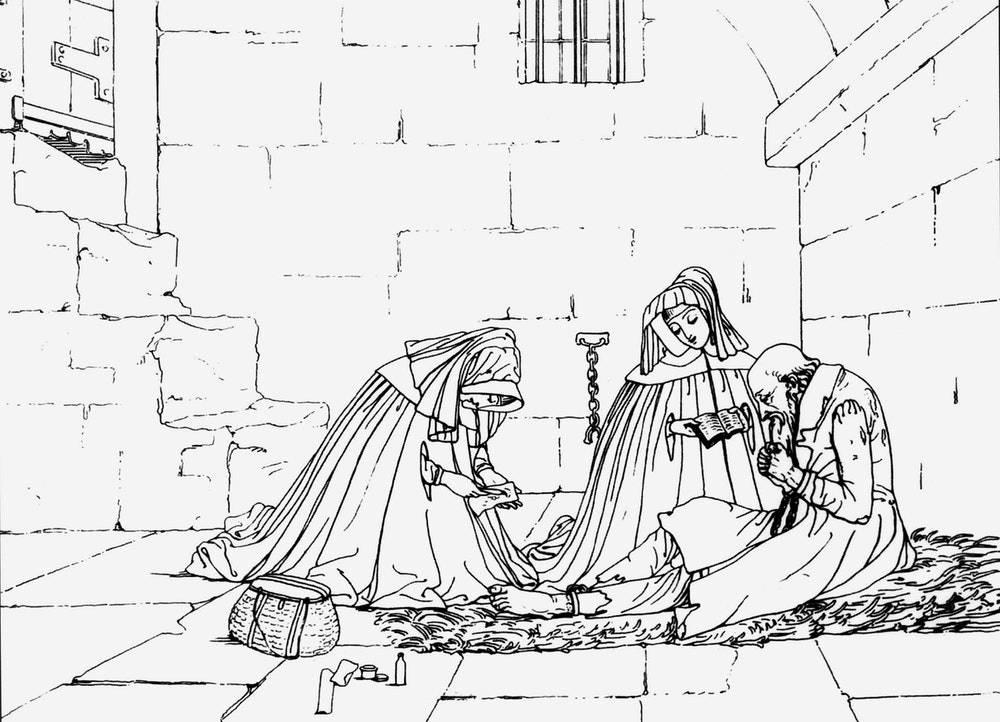
Currently, in many prisons and jails, volunteers still can’t visit. So where else can we find the imprisoned besides a state women’s prison at Cambridge Springs?
I meet them every day at Mercyhurst University. Students struggling to be OK with themselves—to find meaning in their lives—to believe that they are loved—that God is with them. You are OK because God created you in God’s image—whether a person be straight, LGBTQ+, Black, white, autistic, disabled, etc. We are all one—same DNA—all created by LOVE.
Look around at your neighbors, relatives and friends who struggle to believe in themselves. Many are imprisoned within themselves.
How do we free those who have imprisoned themselves? How do we free ourselves? The answer is love—Luke 6:27-38.
Look around and be aware this Lent. Young persons, the elderly, perhaps, all of us struggle with being accepted for who we are. So many times, persons become who they think people want them to be, and, if not, they believe they are less than.
How do we free ourselves and others from the prisons we have put ourselves in?
“Everything is filled with sacred presence.” (Psalm)
“We are not called by God to do extraordinary things, but to do ordinary things with extraordinary love.” (Jean Vanier)
Inmates are aware that they are imprisoned. This Lent, become aware of how we are imprisoned and of how many who are walking around us are also imprisoned.
This Lent , set aside quiet time to be with God. Or become aware that God is everywhere; so be aware of God in all things, especially the persons with whom you come in contact. Make it a point to greet each person with a smile. Pray especially for people you judge or don’t like. Send God’s love to them. Let God heal…or heal you to accept the person for who they are at this moment. We all possess God.
Pray during this Lent to not judge people and to forgive wrongs that have been done to you. Spend time offering the silence up as a time of love for others. It is easy to give up food for Lent, harder to give up judging and non-forgiving.
This Lent, put more tenderness into the world, and the world we live in will become a more loving place.
Everything is nothing but the expression of God’s exuberance.
- NATION/WORLD
- LIST OF EVENTS
- ADD AN EVENT
- ADVERTISING
- Catholic Podcasts
- The Catholic Conversation
- Parenting Smarts
- The Bishop’s Hour
- Homilies and More

Visit the imprisoned: Terry Samaniego brings mercy, love of God to inmates
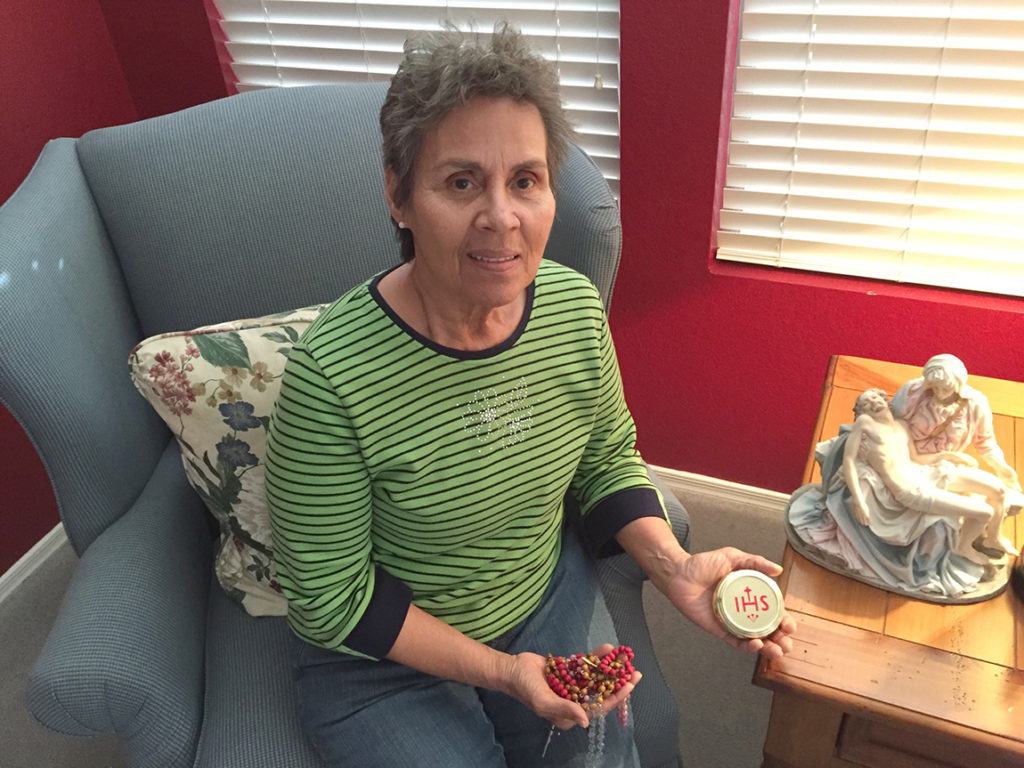
In recognition of the Jubilee Year of Mercy declared by Pope Francis, every month The Catholic Sun will feature a “Missionary of Mercy” who exemplifies one of the corporal or spiritual works of mercy. Practical ways to Visit the Prisoner Donate Walmart gift cards. The prison ministry uses them to buy back-to-school supplies for prisoners’ children Donate paperback or softcover Bibles Sponsor a prisoner’s family at Christmas Info : Kevin Starrs, director of prison ministry, at (602) 354-2485 or [email protected]
T hree years ago, an announcement in the St. Francis Xavier Parish bulletin about visiting inmates in prison caught Terry Samaniego’s eye. With several family members who’ve served time, the plea for volunteers to visit prisoners touched her heart.
“Who died beside Jesus, one to the left and one to the right? Prisoners. What does He say to me? Visit My prisoners,” Samaniego said. “I’m blessed to do this, to visit the ladies in prison.”
Every Tuesday, Samaniego makes the 60-mile round trip to visit the female inmates at the San Pedro Unit, part of the Arizona State Prison Complex in Goodyear .
She humbly acknowledges that but for the grace of God, she might be the one in need of a visitor. She tells the prisoners:
“The difference between you and me is that you got caught.”
That’s because earlier in life, Samaniego did her share of partying and pill-popping. “The reason I didn’t get caught was because someone yanked at my chain and said, ‘Enough is enough’ with the drinking and the partying. It could have been me, and that’s exactly what I tell them.”
“The difference between you and me is that you got caught.” That’s because earlier in life, Samaniego did her share of partying and pill-popping. “The reason I didn’t get caught was because someone yanked at my chain and said, ‘Enough is enough’ with the drinking and the partying. It could have been me, and that’s exactly what I tell them.”
Years ago, Samaniego admits, she used to bar hop. “Now I tell the ladies I church hop. They get a kick out of that.” She’s not kidding, either. Although she lives in South Phoenix, Samaniego works in Chandler. Every other week, she gets off at 5 a.m. on Sunday.
“Instead of coming all the way home, getting dressed and trying to stay awake, I sleep in the car or on a couch at work. When you want to go and see God, you’ll do anything,” Samaniego declared.
She means it, too. The day The Catholic Sun visited her home, she had risen at 2 a.m. to pray. “I do my Rosary and go back to bed, then I get back up and I’ll listen to the Mass on EWTN . Then my day starts. My morning has to be with the Lord, all by ourselves.”
Read more about the Church’s outreach to those in prison
Devotion to the daily Rosary is something she said she learned from the prisoners. About 20 of them gather once a week when Samaniego and another volunteer from St. Francis Xavier hold a Communion service at the prison. Some of the women are pregnant. Many of them worry about their children or the fact that they haven’t had a visit from family. More than anything, Samaniego said she is touched by the one-on-one time with each prisoner.
“It doesn’t matter how big our crime is. Jesus loves us, He does, no matter what we do. You might think that He doesn’t, but He does,” Samaniego tells them.
A couple of times, she’s visited the Lumley unit, where prisoners have been convicted of more serious offenses. “It’s tough, but being in there, you have to just be yourself. You’re going in there to take the Word, to take Communion.”
For those behind bars, it’s a small slice of heaven.
“When you have loved ones in prison, you know that side of it. You know how the guards can be. You know the rules. You’re going in and taking God into prison,” Samaniego said. “We go in there and we pray for one another. We ask for forgiveness. We learn from one another.”
Share this:
Related articles more from author.

Our bodies aren’t the problem

Embracing the sacramental tapestry: A personal journey through Easter reflections

NEWS BRIEF: Pastoral Center staff honors Child Abuse Prevention Month

- Report a Website Error
The Long Journey to Visit a Family Member in Prison
Remote prison towns and strict visitation policies make it hard to stay in touch..

The first time Jodi Calkins visited her son at the federal prison in Seagoville, Texas, the journey took her about 10 hours. From her home in Elkins, West Virginia, she drove three hours to the Pittsburgh International Airport, took a three-hour plane ride to the Dallas Love Field airport, then drove another hour in a rental car to a hotel near Dallas.
After driving an additional hour to the prison, FCI Seagoville, the next day, Calkins was turned away. Her son, Michael James, waited anxiously for hours.
When the mother and son talked on the phone later that night, Jodi explained that she had been blocked from entering the prison because she was wearing a dress with thin, zigzagging black and khaki stripes. Khaki was one of the prohibited colors for visitors at FCI Seagoville.
“Most of these prisons are out in the middle of nowhere, so you can't run out and get a new outfit,” she said. “You learn really quick to fill your trunk with clothing.”

Jodi Calkins at her home in Elkins, West Virginia, in December. The decorations on the wall include framed artwork of the former record label of her son, who is at FCI Seagoville in Texas.
The majority of prisons across the country are located far from the city centers many prisoners—and their families—call home. More than 63 percent of people in state prisons are locked up over 100 miles from their families, a 2015 report from the Prison Policy Initiative found. Black and Latino people make up a disproportionate share of the prison population, but many prison towns are majority white.
Nearly 200 people responded to a Marshall Project callout sharing the routes they travel to visit incarcerated family members. In interviews, many of them said they didn’t have the time, money, childcare or car to make the journey to these facilities as often as they would like. Others said they could not afford to visit at all.
Studies have shown that in-person visits can help families on the outside and their incarcerated loved ones. More frequent visits during incarceration can also reduce the risk that prisoners will re-offend once they are released. But many respondents told us that visitation is an often stressful and sometimes humiliating process for families.
“I would have to psych myself up to go to visitation because it was so emotionally and physically draining,” said Calkins, who visited her son and her son’s father in separate prisons for decades.
Jodi Calkins’s journey
1,250 miles 10 hours

Pittsburgh International Airport
Calkins drove three hours from her home in Elkins, W.V. to Pittsburgh International Airport. She then flew to Dallas, where she rented a car.
Elkins, W.V.
Dallas Love Field Airport
FCI Seagoville
Driving to the prison took an additional hour.

Love Field Airport

Prison construction exploded during the 1980s and 1990s, bringing with it a promise of economic revitalization. All of the 40 new state prisons built in New York state between 1982 and 2010, for example, were located in rural areas, according to the Vera Institute of Justice .
"The rural prison boom in the United States really coincided with the farm crisis and the loss of manufacturing in rural America," said Tracy Huling, founder of the Prison Public Memory Project, which studies the history of rural prison towns. "Siting prisons was an apparent quick fix. The land was cheaper, and people either wanted them because they were so desperate for anything to keep their communities from collapsing, or it was easier to overcome opposition in a small place, with fewer people and fewer connections to power."
Most prison towns still haven’t been lifted out of poverty, Huling said.
There is also a racial dimension to the geography of prisons. “You have prisons, which lock up black and brown people, in predominantly white rural communities,” Huling said. “These areas have had little exposure to black and brown people outside of the law enforcement arena."
California State Prison Solano opened in 1984 in the rural town of Vacaville, halfway between San Francisco and Sacramento. It was the first new prison constructed in California in two decades.
Every two months, Romanethia Porter visits her husband at the Solano state prison, nearly 500 miles from her home in Riverside, California. If she leaves around 9 a.m., the Amtrak from San Bernardino usually gets her to Sacramento by 8 p.m.
Porter spends the night with her daughter, then takes an Uber to the prison the next morning. A round trip Amtrak ticket costs her about $106, and the Uber is $30 each way. If she took public transportation from Sacramento to the prison, it would take her more than twice as long.
Romanethia Porter’s journey
455 miles 12 hours

Porter takes Amtrak from Riverside, Calif., to Sacramento, a nearly 11-hour trip. She takes an Uber from there to the prison.
State Prison
Los Angeles

The expensive and time-consuming visits are made all the more stressful by the visitation process, which can be unpredictable. "There's a problem if you hold your loved one’s hand,” she said. “If it gets too crowded, they want to cancel the visit."
Because Porter travels more than 250 miles to visit her husband, California Department of Corrections and Rehabilitation policy entitles her to a full six-hour visit. But she said her time with her husband is sometimes cut short nonetheless.
Porter said she sometimes feels out of place in Vacaville, a majority white former agricultural hub now home to a high-end strip mall. She and other African American and Latino visitors sometimes feel disrespected by the corrections staff and by the town's white residents, she said. "It does bother some of the ladies I talk to, the treatment we receive. We’re not inmates."
Most prisons are not accessible by public transportation, making visits especially difficult for those who cannot drive. It’s common for families to share rides with each other or to organize carpools in Facebook groups and online forums.
Before 1988, there was no way to get to Plainfield Correctional Facility in Indiana if you didn't have a car. Cecelia Whitfield started visiting that same year.
Whitfield would drive from Indianapolis to visit a family friend who was incarcerated there. Soon, she started giving rides to other families who lived in the city. “When the families started asking if they could ride with us, I asked them, ‘Doesn’t the state offer transportation?’” she remembered. They said no.
Whitfield would also give rides to families when she visited her son, James Lamont Whitfield, in state prison. By 1990, she said she had put 100,000 miles on her minivan, which held five or six people. That year, she borrowed money from her mortgage and bought a bus to hold more passengers.
Thirty years later, James has been released, but the carpool is still running. Now, it’s expanded into a statewide rideshare service called Use What You’ve Got Prison Ministry that partners with the Department of Correction to offer low-cost rides to economically disadvantaged state residents visiting their loved ones. Whitfield said the demand has slowed down in recent years as state prisons have introduced video calls, but she still sees the value of in-person contact. "The healing touch is much more personal," she said.
Several states, including New Jersey and Florida, have laws requiring corrections departments to "make every effort" to consider the distance from families "whenever possible." And under a provision of the First Step Act, federal prisoners must now be moved within 500 miles of their families.
In most states, however, where prisoners are assigned comes down to other factors, such as security levels, sentence length and the availability of programming, such as drug treatment.
Even in states that consider proximity, transfers are common and travel times can quickly grow from minutes to hours. That's what happened to Denise Rock when her husband was transferred to the Desoto Correctional Institution in Arcadia, Florida, two and a half hours from her home. Before the transfer, he was just 45 minutes away.
Rock continues to visit every weekend, sometimes staying the night in a nearby campground, and said she plans to continue to do so indefinitely. His sentence, for second-degree murder, is 100 years.
"I have seen the positive effects of my presence there,” she said. “Being able to visit keeps him grounded in the real world."
Denise Rock’s journey
116 miles 2.5 hours

Correctional
Institution
Rock drives two and a half hours from her home to visit her husband at Desoto Correctional Institution.

Rock drives at night so she can get to the prison as early as possible. People start lining up along the side of the road leading up to the prison at midnight, she said, because of how long the check-in process takes. By the time the doors to the prison open at 8 a.m., the line of cars can sometimes stretch for a half-mile.
On the weekend of Thanksgiving, Rock arrived at the prison gates at 3:30 a.m. She was the eighth person in line for visitation.
Between 9:10 a.m. when her husband arrived, and 3 p.m., when visitation closed, they played games, walked around together and used the visitation room’s limited food offerings to cook a holiday meal. Rock made her husband "stuffing" from biscuit bread in the microwave. For dessert, they had a tiramisu prepared with cream cheese, creamer, sandwich cookies, hot cocoa and instant coffee.
They shared food with other visitors and their incarcerated family members, some of whom they’ve gotten to know over the years. Despite Desoto holding nearly 1,500 inmates, Rock said she sees the same 50 or 60 families every week.
"I know people who travel many more hours than I do," she said. "I'm one of the lucky ones.”
Our reporting has real impact on the criminal justice system

Our journalism establishes facts, exposes failures and examines solutions for a criminal justice system in crisis. If you believe in what we do, become a member today.
Beatrix Lockwood Twitter Email has reported on criminal justice issues including families of the incarcerated, prison food, and electronic monitoring. She uses social media and engagement reporting to include more community voices in stories.
Nicole Lewis Twitter Email is the engagement editor for The Marshall Project, leading the organization’s strategic efforts to deepen reporting that reaches communities most affected by the criminal legal system.
Stay up to date on our reporting and analysis.
OpenBible.info Geocoding Topical Bible Labs Blog
What does the Bible say about ?
A ‣ B ‣ C ‣ D ‣ E ‣ F ‣ G ‣ H ‣ I ‣ J ‣ K ‣ L ‣ M ‣ N ‣ O ‣ P ‣ Q ‣ R ‣ S ‣ T ‣ U ‣ V ‣ W ‣ Y ‣ Z
7 Bible Verses about Visit The Imprisoned
Hebrews 13:3 esv / 16 helpful votes helpful not helpful.
Remember those who are in prison, as though in prison with them, and those who are mistreated, since you also are in the body.
Matthew 25:36 ESV / 13 helpful votes Helpful Not Helpful
I was naked and you clothed me, I was sick and you visited me, I was in prison and you came to me.’
John 3:12 ESV / 5 helpful votes Helpful Not Helpful
If I have told you earthly things and you do not believe, how can you believe if I tell you heavenly things?
Matthew 25:1-46 ESV / 5 helpful votes Helpful Not Helpful
“Then the kingdom of heaven will be like ten virgins who took their lamps and went to meet the bridegroom. Five of them were foolish, and five were wise. For when the foolish took their lamps, they took no oil with them, but the wise took flasks of oil with their lamps. As the bridegroom was delayed, they all became drowsy and slept. ...
Matthew 1:25 ESV / 3 helpful votes Helpful Not Helpful
But knew her not until she had given birth to a son. And he called his name Jesus.
1 Timothy 3:15 ESV / 2 helpful votes Helpful Not Helpful
If I delay, you may know how one ought to behave in the household of God, which is the church of the living God, a pillar and buttress of the truth.
Matthew 25:40 ESV / 2 helpful votes Helpful Not Helpful
And the King will answer them, ‘Truly, I say to you, as you did it to one of the least of these my brothers, you did it to me.’
Suggest a Verse
Enter a verse reference (e.g., john 3:16-17 ).
Visit the Bible online to search for words if you don’t know the specific passage your’re looking for.
Unless otherwise indicated, all content is licensed under a Creative Commons Attribution License . All Scripture quotations, unless otherwise indicated, are taken from The Holy Bible, English Standard Version. Copyright ©2001 by Crossway Bibles , a publishing ministry of Good News Publishers. Contact me: openbibleinfo (at) gmail.com.
Board Member Portal

A Volunteer Visitation Program to Federal and Military Prisoners Throughout the United States
Why we visit.
Although most people cannot imagine spending years living with little or no contact with the outside world, it is a reality that prisoners across the country face on a day to day basis.
The federal prison system houses more than 198,000 prisoners in over 121 federal and several thousand more in 5 military prisons, many of whom are too far from their homes to get visits from family and friends at any point during their sentence.
Ninety-eight percent of incarcerated people will eventually be released back into society, and the quality of their contact with the outside world will often determine whether they will commit crimes again and return to prison.
With few other opportunities for human contact, many look to Prisoner Visitation and Support for a voice, encouragement, and a chance to reconnect with the world around them.
PVS visitors offer help and moral support to prisoners who seek contact with someone outside the immediate prison community to support them in their struggle to survive their incarceration, to live constructive lives and to maintain their self-esteem.
For many such people, their PVS visitor is their only contact with the outside world, and a friend in their time of confinement.
- PRO Courses Guides New Tech Help Pro Expert Videos About wikiHow Pro Upgrade Sign In
- EDIT Edit this Article
- EXPLORE Tech Help Pro About Us Random Article Quizzes Request a New Article Community Dashboard This Or That Game Popular Categories Arts and Entertainment Artwork Books Movies Computers and Electronics Computers Phone Skills Technology Hacks Health Men's Health Mental Health Women's Health Relationships Dating Love Relationship Issues Hobbies and Crafts Crafts Drawing Games Education & Communication Communication Skills Personal Development Studying Personal Care and Style Fashion Hair Care Personal Hygiene Youth Personal Care School Stuff Dating All Categories Arts and Entertainment Finance and Business Home and Garden Relationship Quizzes Cars & Other Vehicles Food and Entertaining Personal Care and Style Sports and Fitness Computers and Electronics Health Pets and Animals Travel Education & Communication Hobbies and Crafts Philosophy and Religion Work World Family Life Holidays and Traditions Relationships Youth
- Browse Articles
- Learn Something New
- Quizzes Hot
- This Or That Game New
- Train Your Brain
- Explore More
- Support wikiHow
- About wikiHow
- Log in / Sign up
- Finance and Business
- Legal Matters
- Law Enforcement
- Imprisonment
How to Visit Someone in Prison
Last Updated: February 8, 2021 Approved
This article was co-authored by Clinton M. Sandvick, JD, PhD . Clinton M. Sandvick worked as a civil litigator in California for over 7 years. He received his JD from the University of Wisconsin-Madison in 1998 and his PhD in American History from the University of Oregon in 2013. wikiHow marks an article as reader-approved once it receives enough positive feedback. In this case, 94% of readers who voted found the article helpful, earning it our reader-approved status. This article has been viewed 72,399 times.
Visiting someone in prison requires some planning on your part. Once you know which prison the inmate is staying at, you need to make sure that you have been put on the inmate’s visiting list. This may require a letter to the inmate. On the day that you are scheduled to visit, you must be sure to dress appropriately and avoid bringing in any prohibited items. Prisons encourage visitation, and once you understand the ground rules then visitation should go smoothly.
Preparing to Visit

- In the United States, you can find a prisoner in the federal system by visiting the Federal Bureau of Prisons and entering the prisoner’s Inmate Register Number. [2] X Research source
- In England and Wales, you can find a prisoner by visiting https://www.gov.uk/find-prisoner . There is an email and fax number provided for you to contact.

- how to get put on the prisoner’s visitation list
- what identification you need
- what items are prohibited from being brought into the prison
- any dress code

- Most prisons ask prisoners to create a visiting list. The inmate then lists family members, friends, and professionals (like attorneys or parole advisors) on the list. [3] X Research source
- You need to be added to the list before you can visit. In order to ask the inmate to put you on, you will probably need to write a letter and ask to be put on. You should also include relevant information that the inmate might need, such as your full name, address, and phone number. [4] X Research source

- Sometimes these applications will be sent to you before you arrive at the prison, and in some prisons you will fill them out as you wait to be admitted.
Visiting the Prison

- revealing shorts or miniskirts
- halter tops, see-through garments, and belly shirts
- low cut blouses, sleeveless shirts, or dresses with slits up the side, front, or back
- baseball hats
- military fatigues or other clothing that looks like inmate clothing

- your identification
- single car key
- bills or change to use with the vending machine
- a bottle and diaper for a baby

- Check with the prison before showing up for visitation. You want to make sure that you have an acceptable form of identification.

- You may be limited in the amount of touching allowed. Prisons may allow hugs, handshakes, and kisses at the beginning and end of the visit. Otherwise, the guards stationed during visitation may limit touching so that visitors aren’t smuggling contraband to prisoners.
- If a guard tells you to stop touching, then you should comply with the order. You may be removed from the visitation if you fail to comply.
Expert Q&A
- Prisons might have different rules for minors. For example, minors under a certain age may not be able to visit without an adult present. If someone under 18 wants to visit the prison, then you certainly need to call ahead and ask if there are special procedures for minors. Thanks Helpful 2 Not Helpful 0

You Might Also Like

- ↑ https://www2.illinois.gov/idoc/offender/pages/inmatesearch.aspx
- ↑ https://www.bop.gov/inmates/visiting.jsp
- ↑ http://www.prisonpro.com/content/visiting-inmate-answers-common-questions-things-you-should-know
About This Article

Visiting someone in prison can be stressful and emotional, but knowing the rules and regulations before your visit will make things easier. Since rules vary from prison to prison, it’s best to check their website or call them for details about what to do. Usually, the prisoner will need to put you on their visiting list and you’ll need to fill out an application when you get there. Since prisons can sometimes get locked down, it’s a good idea to call ahead to make sure visiting hours are still open. Try to arrive 20 minutes early so you have time to park and go through security, and remember to bring your ID with you. For more tips from our Legal co-author, including how to find out which prison a person is held at, read on. Did this summary help you? Yes No
- Send fan mail to authors
Reader Success Stories
M. Hodkinson
Feb 10, 2019
Did this article help you?

Windy Hudgins
Feb 12, 2017

Featured Articles

Trending Articles

Watch Articles

- Terms of Use
- Privacy Policy
- Do Not Sell or Share My Info
- Not Selling Info
Get all the best how-tos!
Sign up for wikiHow's weekly email newsletter

IMAGES
VIDEO
COMMENTS
June 22, 2016. Father Michael Van Sloun. 0. To visit the imprisoned is a corporal work of mercy. Jesus mentioned it specifically when he said, "For I was . . . in prison and you visited me" (Mt 25:35, 36). Jesus has mercy for "the least," those despised by others. Convicts rank high among "the least.". For the general public, when a ...
Visit the sick Visit the imprisoned Bury the dead. Step 3 - Explanation: This step will address a specific Work of Mercy. This Month: Visit the Imprisoned. All of the Works of Mercy boil down to this: "Beloved, if God so loved us, we also must love one another. (1 Jn 4:11)" The Works of Mercy provide ways in which we can love better. The ...
What we see in the life of Mother Teresa is a shining example of a life dedicated especially to practicing the corporal works of mercy: (1) Feed the hungry. (2) Give drink to the thirsty. (3) Clothe the naked. (4) Shelter the homeless. (5) Visit those in prison. (6) Comfort the sick. (7) Bury the dead.
According to a 2012 Pew Forum Survey of U.S. prison chaplains, prisons are a "bustle of religious activity.". Seventy-four percent say attempts by inmates to convert or proselytize other ...
Philip Kosloski Blogs January 11, 2016. The next corporal work of mercy includes two separate acts: "ransoming the captive" and "visiting the imprisoned.". For the purposes of this article ...
The fifth Corporal Work of Mercy is "Visit the Imprisoned.". This work of mercy is important, and often neglected. When I was in college, I had the privilege of being involved in the Legion of Mary, a Catholic lay apostolate that began in Ireland, that involves a commitment of two hours of apostolic work done each week, always with a ...
So, too, should we see and help those who are imprisoned by a variety of walls. We should see them, not as they are, but for what they should and can be: free and joyful children of God. They need us to visit them in their prisons and to minister to them with compassion. We may not be able to cure them of their torment, as Jesus did with the ...
jail or prison and the need for training in how to minister to the imprisoned. Respecting human dignity may dictate that you don't, personally, visit those in prison. Find out who in your area is visiting prisoners. Ask how you can provide support or get involved. Above all, pray for those in prison. Don't limit your imagination.
Visit the sick; Visit the imprisoned; Bury the dead; How can families live this out? Especially with young children, hands-on charitable work can be daunting, but not impossible. The works of mercy will look different for each family - and can be practiced very literally when it comes to caring for children! But if you have a desire to ...
Jesus' powerful words in the Gospel of Matthew form the basis for the traditional list of the works of mercy. When it comes to meeting physical needs, the Compendium to the Catechism of the Catholic Church lists the following actions as the corporal works of mercy: Feed the hungry. Give drink to the thirsty. Clothe the naked. Shelter the ...
The priests, Sisters, deacons and lay pastoral agents of the Vicariate of Maipo decided that we were called to live out the corporal work of mercy: to visit the imprisoned. Visitation at the overcrowded prison. We based our decision on the fact that Puente Alto has a prison with 1300 male inmates. It was built to house 700 inmates.
I would contend that charity and justice are the caterpillar and butterfly of living out the Gospel message. Encounter with another through the Corporal Works of Mercy gives birth to personal transformation and a renewed hunger for justice. A desire to live charitably led me to Tom, and in turn, Tom led me to be challenged and changed.
To Visit the Imprisoned. It's a corporal work of mercy that, so often in my life, I've opted to sort of skirt around. I'm a mother, after all, and this means vigilance when it comes to my family. And so the thought of visiting the imprisoned has seemed something to avoid. And yet, lately, God has very directly been tapping me.
Visit the Imprisoned. In this year's Lenten reflection series, seven sisters offer their personal stories and insights on each of the Corporal Works of Mercy and how acts of mercy can have a profound impact on the lives of our sisters and brothers. Accompanying these reflections are line drawings by Sister Mary Clare Agnew, a contemporary of ...
Sponsor a prisoner's family at Christmas. Info: Kevin Starrs, director of prison ministry, at (602) 354-2485 or [email protected]. Three years ago, an announcement in the St. Francis ...
Rock drives at night so she can get to the prison as early as possible. People start lining up along the side of the road leading up to the prison at midnight, she said, because of how long the check-in process takes. By the time the doors to the prison open at 8 a.m., the line of cars can sometimes stretch for a half-mile.
Matthew 25:1-46 ESV / 5 helpful votesHelpfulNot Helpful. "Then the kingdom of heaven will be like ten virgins who took their lamps and went to meet the bridegroom. Five of them were foolish, and five were wise. For when the foolish took their lamps, they took no oil with them, but the wise took flasks of oil with their lamps.
The federal prison system houses more than 198,000 prisoners in over 121 federal and several thousand more in 5 military prisons, many of whom are too far from their homes to get visits from family and friends at any point during their sentence.
Legal Visits. All inmates have a right to legal visits, but the Sixth Amendment does not require full and unfettered contact between an inmate and his or her attorney in all circumstances. If the state denies a contact visit with a lawyer, however, it must provide a rationale.16. 7 Overton, 539 U.S. at 141 (Thomas, J., concurring).
Find the prison's website. Many prisons now have websites. On the website, you can find important information for planning your trip. Look for the website so that you can find out how to schedule a visit. You will also want information about what you can bring. 3. Call to ask about restrictions.
Our findings highlight that although visitation can help maintain social bonds among families, the barriers, processes, and procedures overshadow the visit itself. The weight of such stressors is especially felt by immediate family members and women who visit.
Law and Order, Shawshank Redemption, Lockup, and Orange is the New Black are the source of many of the impressions the general public shares about prisons. The reality is at once better, and worse ...
Since we began in 1961, Amnesty activists have been ready to spring into action for people facing imminent danger in detention. From sending faxes and tweets to making phone calls or taking to the streets. "…. The phone calls to the police during my arrest saved me from torture and rape. The police station was so swamped they stopped ...